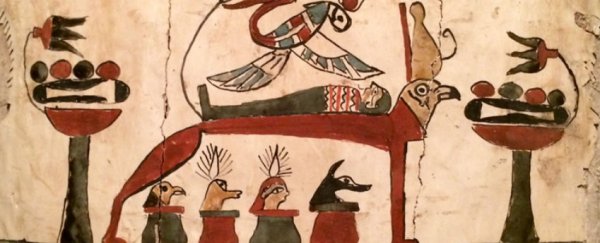Archaeologists have discovered a bizarre scene on an Egyptian coffin that was likely the result of all its good artists having been deported. Left with a bunch of amateurs, it appears that the Egyptian elite had to settle for dud funerary paintings in death during this time.
The coffin was presented to the archaeological community last month at the Society for the Study of Egyptian Antiquities Scholars' Colloquium in Canada by Egyptologist Gayle Gibson from the Royal Ontario Museum. It's owned by US-based collector, Mike Sigler.
The crude and oddly drawn funerary scene depicts the owner of the coffin lying on a special funerary bed, which is decorated with what Gibson assumes is supposed to be the head of the Egyptian god, Ba. Ba was believed to be an aspect of a person's personality, or soul, and would live on after a person has died.
Ba would often be depicted on funerary items flying out of the tomb to reach the afterlife, and according to Laura Demanski at the University of Chicago Magazine, one of the reasons mummies wear masks is so their Ba can recognise who to fly back to. But everything about this particular Ba is odd. "This is the only funerary bed I know of with a Ba's head," Gibson told the audience at the event last month. "We [also] have a winged snake with Hathor's crown - very odd." Gibson also called the jars with heads "goofy". Because let's face it, they really are.
 Mike Sigler
Mike Sigler
Owen Jarus at Live Science points out more of the scene's oddities:
"The collar wrapped around the top of the coffin contains two creatures that look almost fishlike. The artist was likely trying to draw falcons, a symbol of the god Horus, but drew them very poorly, Gibson said.
A Mehen snake, a protective deity in Egypt, is also poorly drawn and actually stops at one point and starts in another, something strange for a protective deity. 'The artist doesn't really understand the purpose of the Mehen snake,' Gibson said."
So what is going on here? After King Cambyses of Persia stormed the ancient Egyptian capital of Memphis in 525 BC, the growth and prosperity of Egypt was disrupted for more than a century, as skilled workers were taken from their homes to help the rapidly expanding Persian Empire.
"Many of the best artists in Egypt were taken by the Persians back to Persepolis and Susa as POWs and war booty - you can see their work in those places. There seems to have been a dearth of masters for some time, so that fewer and fewer artists got proper training," Gibson told Jarus.
According to Live Science, the coffin was found without a mummy inside, but judging from the inscriptions it bears, it likely belonged to a woman. Radiocarbon dating places the origin of the coffin at a time when Egypt was run by the Persian Empire, and ancient documents speak of a mass deportation of Egyptian artists at this time to Persia. Along with supplies of precious metals, King Cambyses took Egypt's greatest artists to help build and beautify his own country.
 Mike Sigler
Mike Sigler
Sources: LiveScience, University of Chicago Magazine
